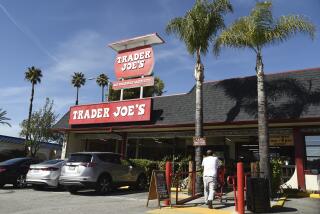Campbell Tries Heating Up the Soup With a New Label
- Share via
CAMDEN, N.J. — Campbell Soup Co. is tampering with an American icon: the red-and-white soup label popularized by pop artist Andy Warhol.
The company says it’s the most significant change in its history and will include 70 varieties in its condensed soup line. The new label has a photograph of a bowl of soup at the center, a recipe on the back and a colored banner to distinguish the soup category.
Since 1898, Campbell has made only 14 minor changes to the red-and-white label. The last change was made for select varieties in 1994 to mark the company’s 125th anniversary.
“The design is much loved and very familiar to Americans, but we felt there was a wonderful opportunity to update it and refresh it,” said Lisa Zakrajsek, vice president of the company’s U.S. soup division.
Campbell ranks sixth among U.S. food companies and controls 80% of the American market for condensed soups. Campbell also sells food under its Prego, V-8 juices, Godiva chocolates, Pace and Pepperidge Farms brands.
The Camden, N.J.-based food maker will formally unveil the redesigned label today in Pittsburgh, where a symbolic replica of the last can of condensed tomato soup bearing the old label will be inducted into the Andy Warhol Museum.
Warhol made the Campbell cans famous with more than 100 portraits and paintings showing the red-and-white label. Warhol, who died in 1987, began painting the soup cans in 1962.
The familiar labels that have lined supermarket shelves for more than a century will begin disappearing by mid-September. The average consumer, however, may not notice the seemingly subtle changes.
The new label resembles changes Campbell made in 1994, but back then the company excluded its three biggest-selling soups from the new look: tomato, chicken noodle and cream of mushroom. This time, the change will include the entire classic soup line.
The red-and-white Campbell label made its debut in 1898, a year after the company began producing condensed soups in Camden. In 1900, the company added a graphic touting its gold medallion award for excellence. Slight changes in lettering were also made in 1905 and 1993.
Zakrajsek admits it may be risky for Campbell to alter its world-famous label. The company believes the new label, however, will make it easier for consumers to find their favorite variety on store shelves.
Cans bearing the new look on some varieties of soup are already appearing in supermarkets. The banners identify categories such as “fun favorites” and “98% fat free.”
“Campbell Soup has been around a very long time,” Zakrajsek said in an interview. “We want to stay fresh and contemporary. Our intent was not to tamper with, but rather enhance, the very powerful label that it is today.”
The Campbell name is smaller on the new label and the gold medallion that had been in the center of the can is higher. While still red-and-white, the label now has a slightly brighter shade of red.
“It’s still Campbell Soup,” Zakrajsek said.
Over the years, Campbell has tried various marketing strategies. Once it put its “M’m m’m good” advertising slogan on the back burner to use a less-catchy campaign theme, “Never underestimate the power of soup.”
More to Read
Eat your way across L.A.
Get our weekly Tasting Notes newsletter for reviews, news and more.
You may occasionally receive promotional content from the Los Angeles Times.










